Abstract
Antagonists of luteinizing hormone-releasing hormone (LH-RH), unlike the LH-RH agonists, suppress gonadotropins and sex steroid secretion immediately after administration, without initial stimulatory effects. [Ac-D-Nal(2)1,D-Ph(4Cl)2,D-Pal(3)3,D-Cit6,D-Ala10]LH-R H (SB-75; Cetrorelix) is a modern, potent antagonistic analog of LH-RH. In this study, the binding characteristics of receptors for LH-RH in membrane fractions from rat anterior pituitaries were investigated after a single injection of Cetrorelix at a dose of 100 microg per rat. To determine whether the treatment with Cetrorelix can affect the concentration of measurable LH-RH binding sites, we applied an in vitro method to desaturate LH-RH receptors by chaotropic agents such as manganous chloride (MnCl2) and ammonium thiocyanate (NH4SCN). Our results show that the percentages of occupied LH-RH receptors at 1, 3, and 6 h after administration of Cetrorelix were approximately 28%, 14%, and 10%, respectively, of total receptors. At later time intervals, we could not detect occupied LH-RH binding sites. Ligand competition assays, following in vitro desaturation, demonstrated that rat pituitary LH-RH receptors were significantly (P < 0.01) down-regulated for at least 72 h after administration of Cetrorelix. The lowest receptor concentration was found 3-6 h after Cetrorelix treatment and a recovery in receptor number began within approximately 24 h. The down-regulation of LH-RH binding sites induced by Cetrorelix was accompanied by serum LH and testosterone suppression. Higher LH-RH receptor concentrations coincided with elevated serum hormone levels at later time intervals. Our results indicate that administration of LH-RH antagonist Cetrorelix produces a marked down-regulation of pituitary receptors for LH-RH and not merely an occupancy of binding sites.
Full text
PDF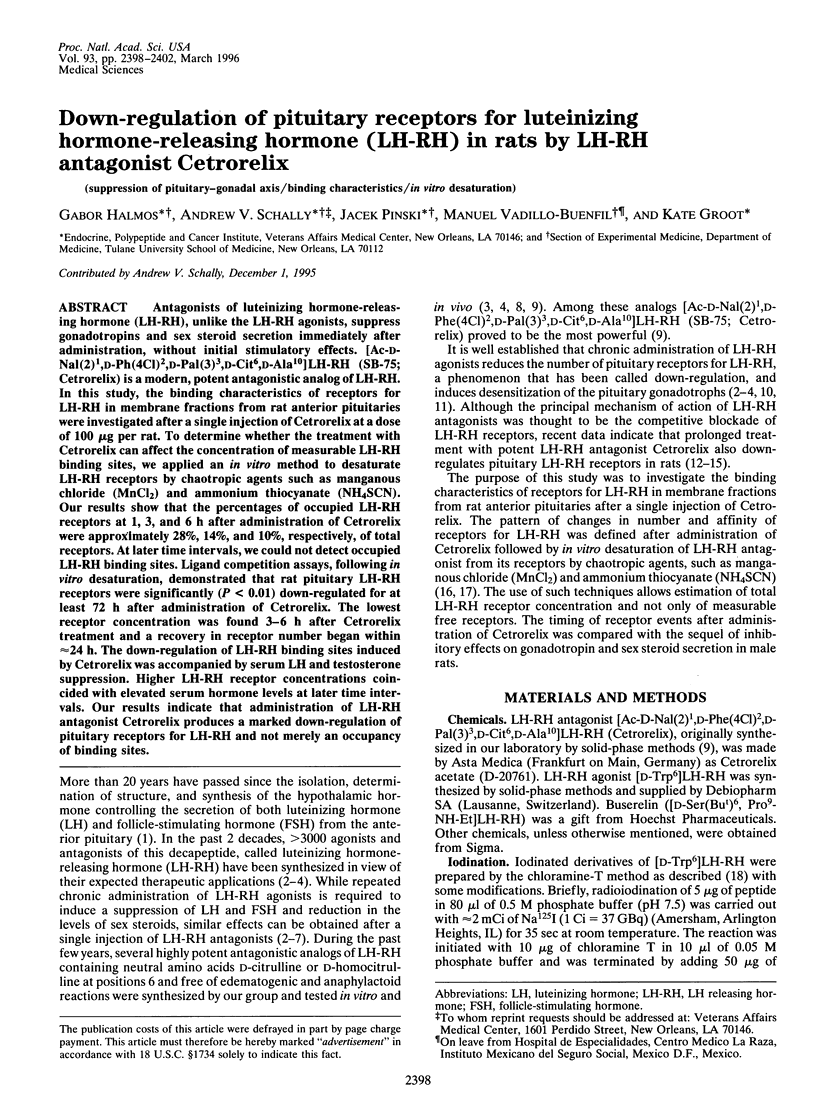
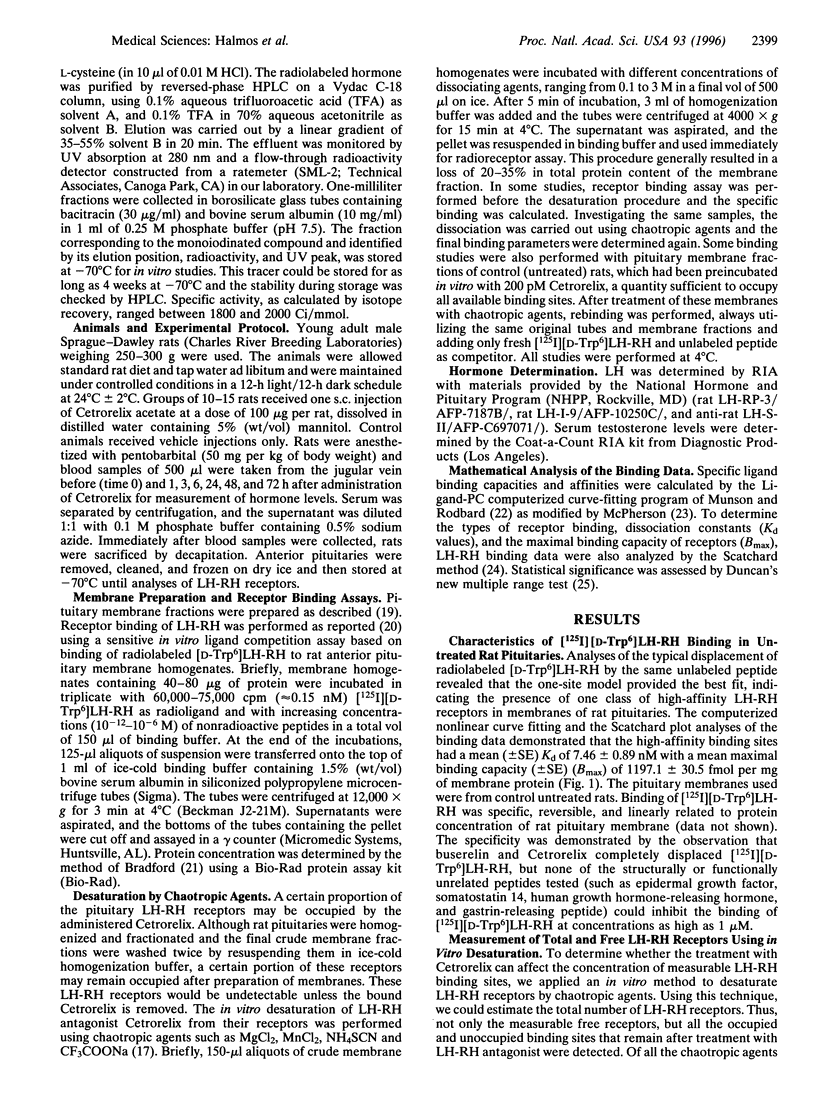
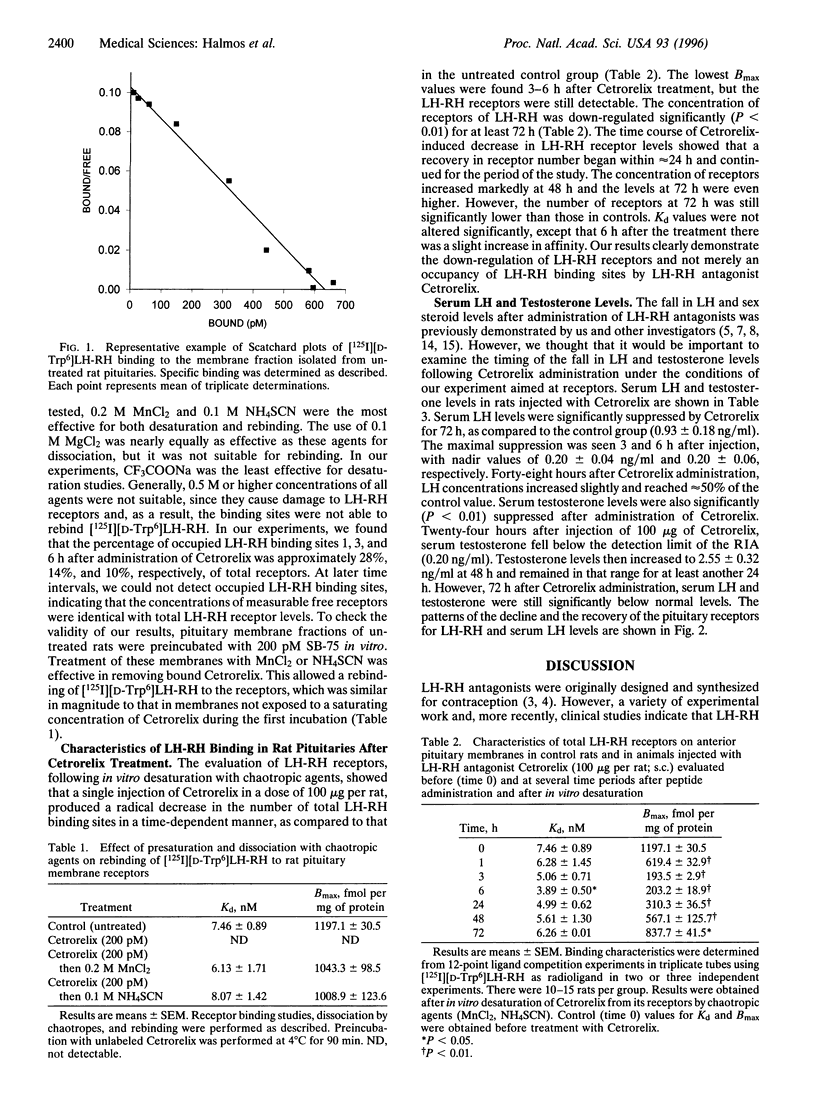
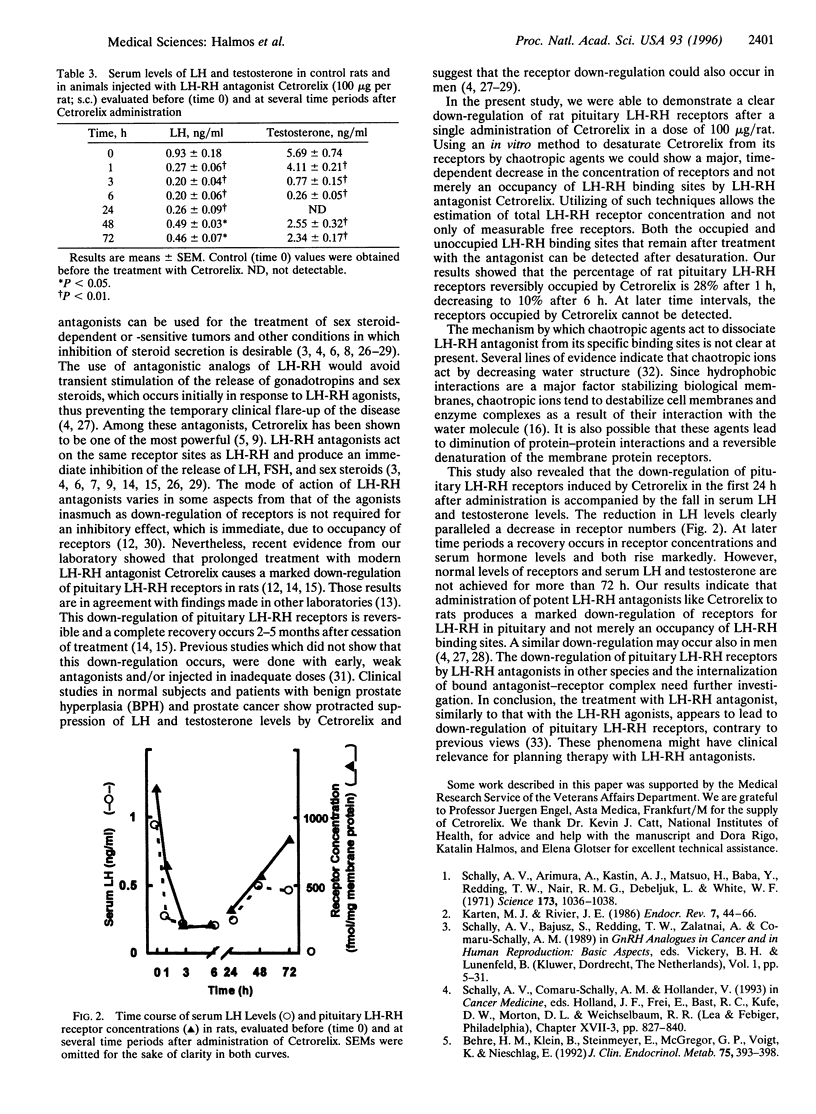
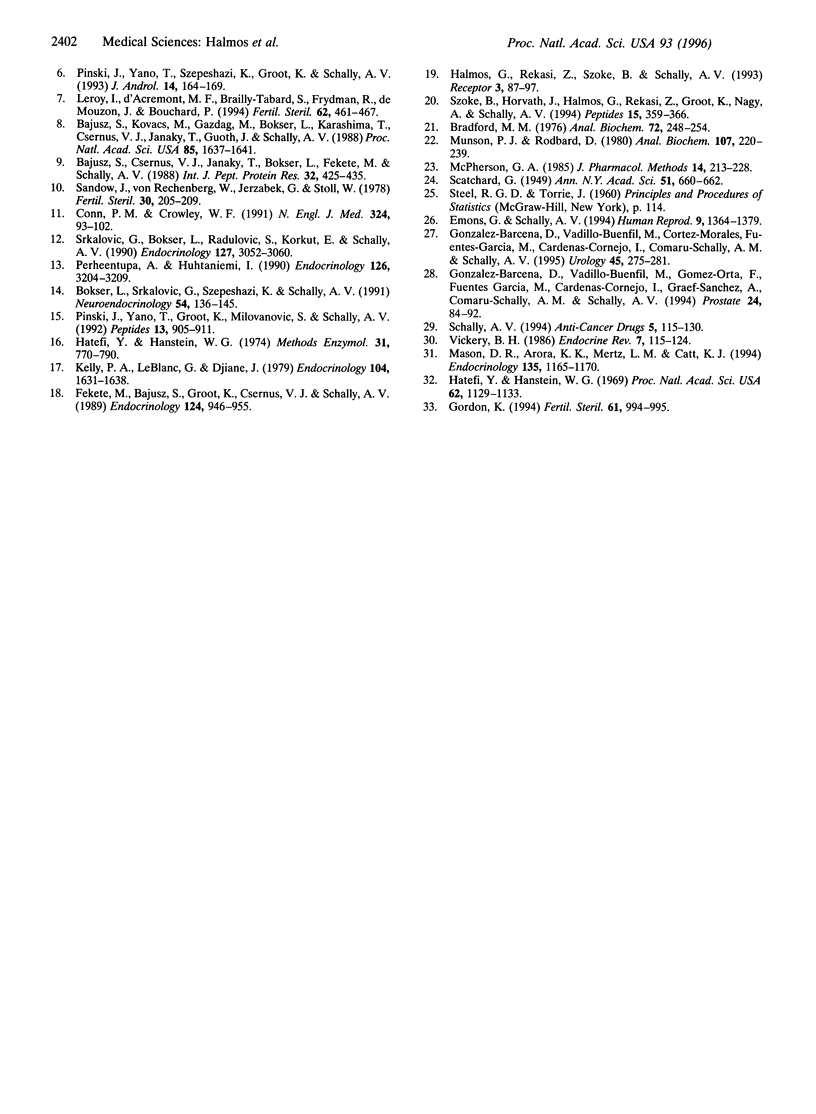
Selected References
These references are in PubMed. This may not be the complete list of references from this article.
- Bajusz S., Csernus V. J., Janaky T., Bokser L., Fekete M., Schally A. V. New antagonists of LHRH. II. Inhibition and potentiation of LHRH by closely related analogues. Int J Pept Protein Res. 1988 Dec;32(6):425–435. doi: 10.1111/j.1399-3011.1988.tb01373.x. [DOI] [PubMed] [Google Scholar]
- Bajusz S., Kovacs M., Gazdag M., Bokser L., Karashima T., Csernus V. J., Janaky T., Guoth J., Schally A. V. Highly potent antagonists of luteinizing hormone-releasing hormone free of edematogenic effects. Proc Natl Acad Sci U S A. 1988 Mar;85(5):1637–1641. doi: 10.1073/pnas.85.5.1637. [DOI] [PMC free article] [PubMed] [Google Scholar]
- Behre H. M., Klein B., Steinmeyer E., McGregor G. P., Voigt K., Nieschlag E. Effective suppression of luteinizing hormone and testosterone by single doses of the new gonadotropin-releasing hormone antagonist cetrorelix (SB-75) in normal men. J Clin Endocrinol Metab. 1992 Aug;75(2):393–398. doi: 10.1210/jcem.75.2.1639941. [DOI] [PubMed] [Google Scholar]
- Bokser L., Srkalovic G., Szepeshazi K., Schally A. V. Recovery of pituitary-gonadal function in male and female rats after prolonged administration of a potent antagonist of luteinizing hormone-releasing hormone (SB-75). Neuroendocrinology. 1991 Aug;54(2):136–145. doi: 10.1159/000125862. [DOI] [PubMed] [Google Scholar]
- Bradford M. M. A rapid and sensitive method for the quantitation of microgram quantities of protein utilizing the principle of protein-dye binding. Anal Biochem. 1976 May 7;72:248–254. doi: 10.1006/abio.1976.9999. [DOI] [PubMed] [Google Scholar]
- Conn P. M., Crowley W. F., Jr Gonadotropin-releasing hormone and its analogues. N Engl J Med. 1991 Jan 10;324(2):93–103. doi: 10.1056/NEJM199101103240205. [DOI] [PubMed] [Google Scholar]
- Emons G., Schally A. V. The use of luteinizing hormone releasing hormone agonists and antagonists in gynaecological cancers. Hum Reprod. 1994 Jul;9(7):1364–1379. doi: 10.1093/oxfordjournals.humrep.a138714. [DOI] [PubMed] [Google Scholar]
- Fekete M., Bajusz S., Groot K., Csernus V. J., Schally A. V. Comparison of different agonists and antagonists of luteinizing hormone-releasing hormone for receptor-binding ability to rat pituitary and human breast cancer membranes. Endocrinology. 1989 Feb;124(2):946–955. doi: 10.1210/endo-124-2-946. [DOI] [PubMed] [Google Scholar]
- Gonzalez-Barcena D., Vadillo-Buenfil M., Cortez-Morales A., Fuentes-Garcia M., Cardenas-Cornejo I., Comaru-Schally A. M., Schally A. V. Luteinizing hormone-releasing hormone antagonist cetrorelix as primary single therapy in patients with advanced prostatic cancer and paraplegia due to metastatic invasion of spinal cord. Urology. 1995 Feb;45(2):275–281. doi: 10.1016/0090-4295(95)80018-2. [DOI] [PubMed] [Google Scholar]
- Gonzalez-Barcena D., Vadillo-Buenfil M., Gomez-Orta F., Fuentes Garcia M., Cardenas-Cornejo I., Graef-Sanchez A., Comaru-Schally A. M., Schally A. V. Responses to the antagonistic analog of LH-RH (SB-75, Cetrorelix) in patients with benign prostatic hyperplasia and prostatic cancer. Prostate. 1994;24(2):84–92. doi: 10.1002/pros.2990240206. [DOI] [PubMed] [Google Scholar]
- Gordon K. Terminology for GnRH antagonists. Fertil Steril. 1994 May;61(5):994–995. doi: 10.1016/s0015-0282(16)56723-5. [DOI] [PubMed] [Google Scholar]
- Halmos G., Rekasi Z., Szoke B., Schally A. V. Use of radioreceptor assay and cell superfusion system for in vitro screening of analogs of growth hormone-releasing hormone. Receptor. 1993 Summer;3(2):87–97. [PubMed] [Google Scholar]
- Hatefi Y., Hanstein W. G. Destabilization of membranes with chaotropic ions. Methods Enzymol. 1974;31:770–790. doi: 10.1016/0076-6879(74)31080-4. [DOI] [PubMed] [Google Scholar]
- Hatefi Y., Hanstein W. G. Solubilization of particulate proteins and nonelectrolytes by chaotropic agents. Proc Natl Acad Sci U S A. 1969 Apr;62(4):1129–1136. doi: 10.1073/pnas.62.4.1129. [DOI] [PMC free article] [PubMed] [Google Scholar]
- Karten M. J., Rivier J. E. Gonadotropin-releasing hormone analog design. Structure-function studies toward the development of agonists and antagonists: rationale and perspective. Endocr Rev. 1986 Feb;7(1):44–66. doi: 10.1210/edrv-7-1-44. [DOI] [PubMed] [Google Scholar]
- Kelly P. A., Leblanc G., Djiane J. Estimation of total prolactin-binding sites after in vitro desaturation. Endocrinology. 1979 Jun;104(6):1631–1638. doi: 10.1210/endo-104-6-1631. [DOI] [PubMed] [Google Scholar]
- Leroy I., d'Acremont M., Brailly-Tabard S., Frydman R., de Mouzon J., Bouchard P. A single injection of a gonadotropin-releasing hormone (GnRH) antagonist (Cetrorelix) postpones the luteinizing hormone (LH) surge: further evidence for the role of GnRH during the LH surge. Fertil Steril. 1994 Sep;62(3):461–467. doi: 10.1016/s0015-0282(16)56932-5. [DOI] [PubMed] [Google Scholar]
- Mason D. R., Arora K. K., Mertz L. M., Catt K. J. Homologous down-regulation of gonadotropin-releasing hormone receptor sites and messenger ribonucleic acid transcripts in alpha T3-1 cells. Endocrinology. 1994 Sep;135(3):1165–1170. doi: 10.1210/endo.135.3.8070359. [DOI] [PubMed] [Google Scholar]
- McPherson G. A. Analysis of radioligand binding experiments. A collection of computer programs for the IBM PC. J Pharmacol Methods. 1985 Nov;14(3):213–228. doi: 10.1016/0160-5402(85)90034-8. [DOI] [PubMed] [Google Scholar]
- Munson P. J., Rodbard D. Ligand: a versatile computerized approach for characterization of ligand-binding systems. Anal Biochem. 1980 Sep 1;107(1):220–239. doi: 10.1016/0003-2697(80)90515-1. [DOI] [PubMed] [Google Scholar]
- Perheentupa A., Huhtaniemi I. Gonadotropin gene expression and secretion in gonadotropin-releasing hormone antagonist-treated male rats: effect of sex steroid replacement. Endocrinology. 1990 Jun;126(6):3204–3209. doi: 10.1210/endo-126-6-3204. [DOI] [PubMed] [Google Scholar]
- Pinski J., Yano T., Groot K., Milovanovic S., Schally A. V. Comparison of biological effects of a sustained delivery system and nonencapsulated LH-RH antagonist SB-75 in rats. Peptides. 1992 Sep-Oct;13(5):905–911. doi: 10.1016/0196-9781(92)90048-8. [DOI] [PubMed] [Google Scholar]
- Pinski J., Yano T., Szepeshazi K., Groot K., Schally A. V. Recovery of pituitary-gonadal function in male rats after long-term suppression induced by a single injection of microcapsules of LH-RH antagonist cetrorelix (SB-75). J Androl. 1993 May-Jun;14(3):164–169. [PubMed] [Google Scholar]
- Sandow J., Von Rechenberg W., Jerzabek G., Stoll W. Pituitary gonadotropin inhibition by a highly active analog of luteinizing hormone-releasing hormone. Fertil Steril. 1978 Aug;30(2):205–209. doi: 10.1016/s0015-0282(16)43461-8. [DOI] [PubMed] [Google Scholar]
- Schally A. V., Arimura A., Kastin A. J., Matsuo H., Baba Y., Redding T. W., Nair R. M., Debeljuk L., White W. F. Gonadotropin-releasing hormone: one polypeptide regulates secretion of luteinizing and follicle-stimulating hormones. Science. 1971 Sep 10;173(4001):1036–1038. doi: 10.1126/science.173.4001.1036. [DOI] [PubMed] [Google Scholar]
- Schally A. V. Hypothalamic hormones: from neuroendocrinology to cancer therapy. Anticancer Drugs. 1994 Apr;5(2):115–130. [PubMed] [Google Scholar]
- Srkalovic G., Bokser L., Radulovic S., Korkut E., Schally A. V. Receptors for luteinizing hormone-releasing hormone (LHRH) in Dunning R3327 prostate cancers and rat anterior pituitaries after treatment with a sustained delivery system of LHRH antagonist SB-75. Endocrinology. 1990 Dec;127(6):3052–3060. doi: 10.1210/endo-127-6-3052. [DOI] [PubMed] [Google Scholar]
- Szöke B., Horváth J., Halmos G., Rékási Z., Groot K., Nagy A., Schally A. V. LH-RH analogue carrying a cytotoxic radical is internalized by rat pituitary cells in vitro. Peptides. 1994;15(2):359–366. doi: 10.1016/0196-9781(94)90024-8. [DOI] [PubMed] [Google Scholar]
- Vickery B. H. Comparison of the potential for therapeutic utilities with gonadotropin-releasing hormone agonists and antagonists. Endocr Rev. 1986 Feb;7(1):115–124. doi: 10.1210/edrv-7-1-115. [DOI] [PubMed] [Google Scholar]


